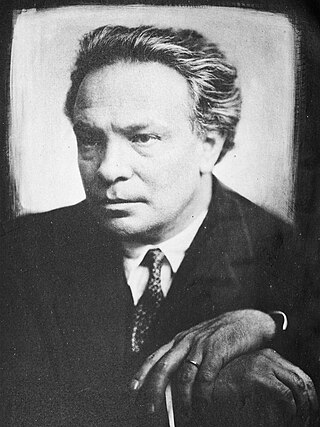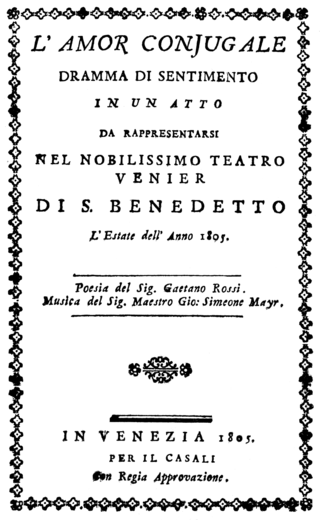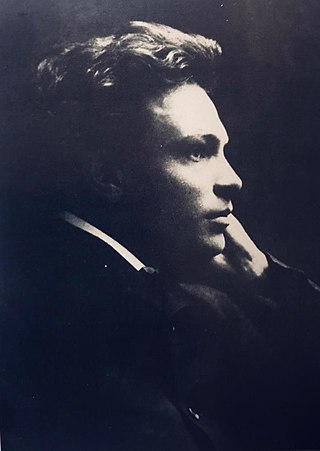
Ottorino Respighi was an Italian composer, violinist, teacher, and musicologist and one of the leading Italian composers of the early 20th century. His compositions range over operas, ballets, orchestral suites, choral songs, chamber music, and transcriptions of Italian compositions of the 16th–18th centuries, but his best known and most performed works are his three orchestral tone poems which brought him international fame: Fountains of Rome (1916), Pines of Rome (1924), and Roman Festivals (1928).

La campana sommersa is an opera in four acts by Italian composer Ottorino Respighi. Its libretto is by Claudio Guastalla, based on the play Die versunkene Glocke by German author Gerhart Hauptmann. The opera's premiere was on 18 November 1927 in Hamburg, Germany. Respighi's regular publisher, Ricordi, was displeased by his choice of subject, and refused to publish the opera. This led to its being published by the German publisher Bote & Bock, and a German premiere.

Maria egiziaca is an opera in one act, in three episodes, by the Italian composer Ottorino Respighi. The libretto, by Claudio Guastalla, is based on a Medieval life of Saint Mary of Egypt, contained in the translation into the vernacular of the Vitae Patrum written by Domenico Cavalca.

Belfagor is an Italian-language opera by the composer Ottorino Respighi to a libretto by Claudio Guastalla (1880–1948) based on the comedy Belfagor of Ercole Luigi Morselli (1882–1921), itself loosely based on the novella Belfagor arcidiavolo by Niccolò Machiavelli. It was premiered in 1923 at La Scala in Milan, under the baton of Antonio Guarnieri, since Toscanini was unavailable. The cast featured Irish soprano Margaret Burke Sheridan as Candida, baritone Mariano Stabile as her lover Baldo, and tenor Francesco Merli as the titular Belfagor, an arcidiavolo (Archdemon) who tries to marry a human maiden while in disguise as a nobleman, using gifts of money to her father.

Medea is an opera in three acts composed by Giovanni Pacini to a libretto by Benedetto Castiglia. It premiered on 28 November 1843 at the Teatro Carolino in Palermo, conducted by the composer with Geltrude Bortolotti in the title role. The libretto is based on the plays Medea by Euripides and Médée by Pierre Corneille.

L'amor coniugale is an opera in one act by Simon Mayr set to an Italian libretto by Gaetano Rossi. It premiered at Padua's Teatro Nuovo on 26 July 1805.

La fiamma is an opera in three acts by Ottorino Respighi to a libretto by Claudio Guastalla based on Hans Wiers-Jenssen's 1908 play Anne Pedersdotter, The Witch. The plot is loosely based on the story of Anne Pedersdotter, a Norwegian woman who was accused of witchcraft and burnt at the stake in 1590. However, Respighi and Guastalla changed the setting of the opera to 7th century Ravenna. The melodramatic tale involves the illicit love of Silvana, the daughter of a witch, for her stepson Donello. When her husband Basilio dies of a heart attack, Silvana is accused of causing his death by witchcraft and is condemned to death. La fiamma premiered to considerable success on 23 January 1934 at the Teatro Reale dell'Opera in Rome in a performance conducted by Respighi himself. The production was directed by Alessandro Sanine with sets designed by Nicola Benois.

Kleider machen Leute is a comic opera in a prologue and two acts by Austrian composer Alexander Zemlinsky. The libretto was written by Leo Feld, based on the 1874 novella of the same name by Gottfried Keller.

Calto is an opera seria in three acts by Francesco Bianchi. The libretto was by Giuseppe Maria Foppa, after the 'Celtic' poetry of Ossian. The opera was first performed at the Teatro San Benedetto in Venice on 23 January 1788.

Marie Victoire is a French-language opera in four acts by the composer Ottorino Respighi to a libretto by Edmond Guiraud (1879–1961) based on his French-language play of the same name, set in the French Revolution.

Ennio Porrino was an Italian composer and teacher. Amongst his compositions were orchestral works, an oratorio and several operas and ballets. His best known work is the symphonic poem Sardegna, a tribute to his native Sardinia, which premiered in Florence in 1933.

Claudio Guastalla was an Italian opera librettist.
Vincenzo Michetti was an Italian composer.

Lucrezia is an opera in one act and three tableaux by Ottorino Respighi to a libretto by Claudio Guastalla, after Livy and William Shakespeare's The Rape of Lucrece, itself based heavily on Ovid's Fasti. Respighi died before finishing the work, which was therefore completed by his wife, Elsa Respighi, and by one of his pupils, Ennio Porrino. Lucrezia premiered on 24 February 1937 at the Teatro alla Scala in Milan, in a production directed by Mario Frigerio with sets designed by Pietro Aschieri. The première had a good reception.

Semirâma is an opera in three acts by Ottorino Respighi to a libretto by Alessandro Cerè based on Voltaire's 1748 play Sémiramis, the same subject used for Rossini's Semiramide. Semirâma premiered on 20 November 1910 at the Teatro Comunale di Bologna. The première obtained a great success, with several calls for the composer and the singers.

Re Enzo is an opera in three acts by Ottorino Respighi to a libretto by Alberto Donini. Re Enzo premiered on 12 March 1905 at the Teatro del Corso in Bologna. The singers were amateurs selected in the world of the Bolognese students; among them, Rosina Giovannoni Zacchi as Lauretta and Ernesto Lavarello as Leonzio. Following the will of the composer, there was a single performance, which obtained a good success.

Maria Carbone was an Italian operatic soprano. She created the lead female roles in two of Gian Francesco Malipiero's operas: the title role in Ecuba and Cleopatra in Antonio e Cleopatra.

Caterina Canzi, also known as Katharina Wallbach-Canzi, was an Austrian-born soprano who sang leading roles in the opera houses of Europe, primarily in Italy and Germany. Amongst the roles she created were Isolde in Lindpaintner's Der Vampyr and the title role in Mercadante's Nitocri.
Magda Piccarolo was an Italian soprano and voice teacher. Active as an opera singer from 1933 through 1959, she was particularly celebrated for her portrayal of Gilda in Giuseppe Verdi’s Rigoletto. She later was active as a teacher of singing both privately and at the Milan Conservatory.












